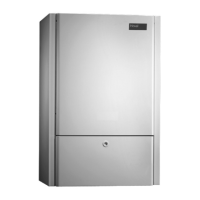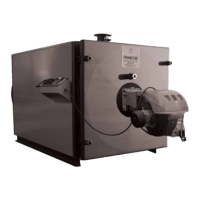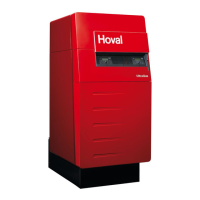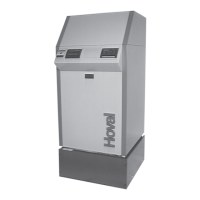36 4 214 283 / 00
OVERVIEW OF SETTINGS
6.3 Inspection & Servicing
-
red to carry out work other than the following: boiler
cleaning, inspection of components for damage, star-
No special equipment is required for normal boiler
servicing.
Tools for cleaning the boiler heating surfaces are
provided with the boiler. If a hard scale forms from oil
-
um (e.g. Carbonex by Arrow Chemicals Ltd) is advan-
tageous for softening and easier removal of such
deposits.
The service engineers› equipment will include any ne-
test kit.
6.3.1 Periodic Inspection
The following periodic inspections should be made bet-
ween main servicing periods.
• Examine boiler casing panels for obvious signs of da-
.ytiruces rof dna ,noitaroireted rehto ro noisorroc ,egam
leads to wasted heat and an increase in the boilerhouse
ambient temperature).
•
Similarly inspect the cleaning explosion door at rear of
boiler.
•
partial blockage, debris, etc.
• Ensure that condensation drains at the chimney base
connected to a drain pipe with a water trap.
•
which may be drawn into the burner and cause dama-
ge.
• Examine all fuel and water valves, connection and bur-
ner etc, for obvious signs of damage or leakage, and
for security.
• In an open-vented heating system, check:
- Level of water in the feed and expansion tank.
- That the ball valve is free to operate correctly.
- All air vents are operating correctly.
NOTE:
No continuous make-up of water should
be taking place. (In this event check whe-
re a leak may be occurring or if pumping
over is taking place).
• On the boiler door, examine the ceramic-strip seal, and
detected by heat marks or deterioration of the metal
ring holding the joint. In the event of such signs, replace
the burner tube and the door lining for deterioration.
Replace when required.
• Initially examine boiler interior after one month when
using class D oil to determine necessity for boiler clea-
ning. When heavy oil is being used, examine after two
weeks. The amount of use, the number of cold starts
involved, and the mean operating temperatures all af-
fect the rate of soot and scale formation.
• A consistent pattern will then be established to determi-
ne the frequency of cleaning required. With gas much
longer periods between cleaning are usually possible.
If condensation occurs due to low return water tempe-
ratures then a build up can occur more quickly. Es-
tablish a pattern to see if cleaning can coincide with
service visits.
•
should initially be more frequent until a reason- able,
consistent pattern can be established.
• On oil/gas burners periodically remove photo electric
ultraviolet cell and clean the window of the cell.
•
at the initial commissioning. Report any unusual altera-
tions in this respect.
Report any occurrences which indicate that the boiler, the
correctly.

